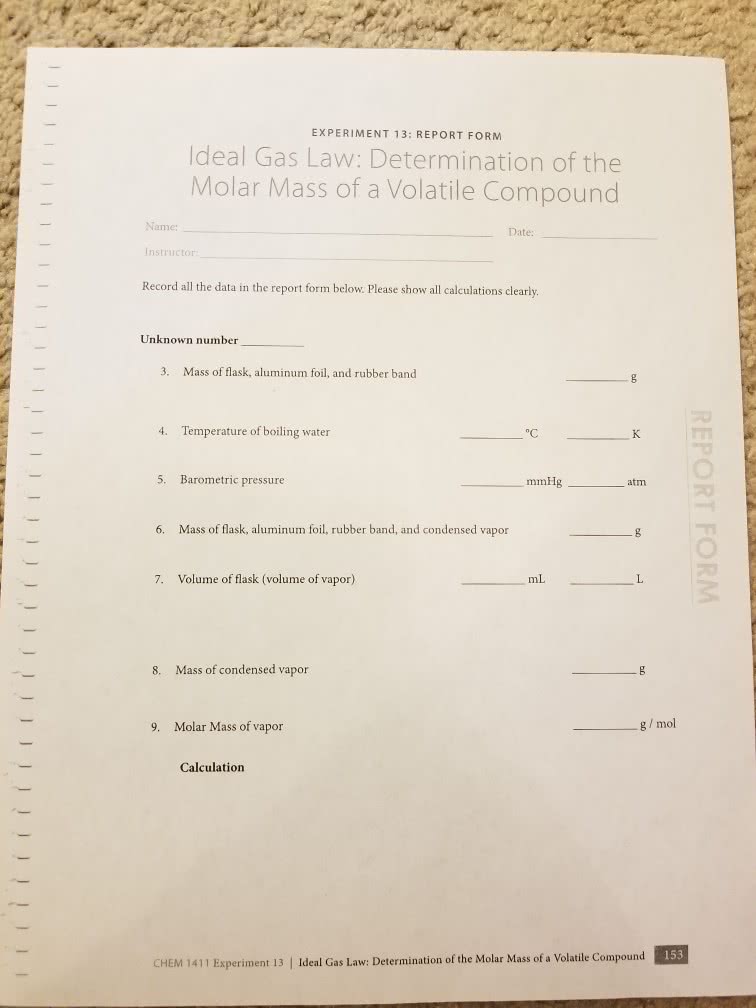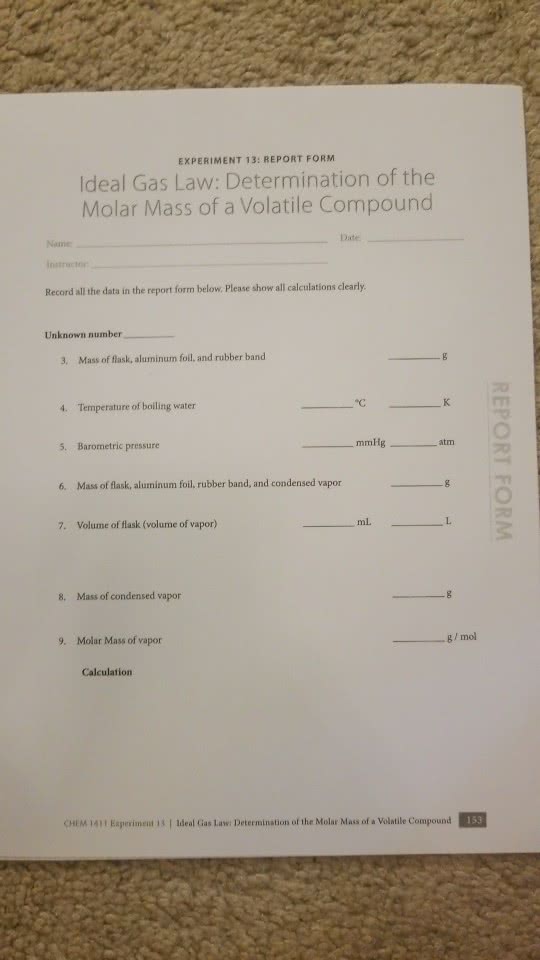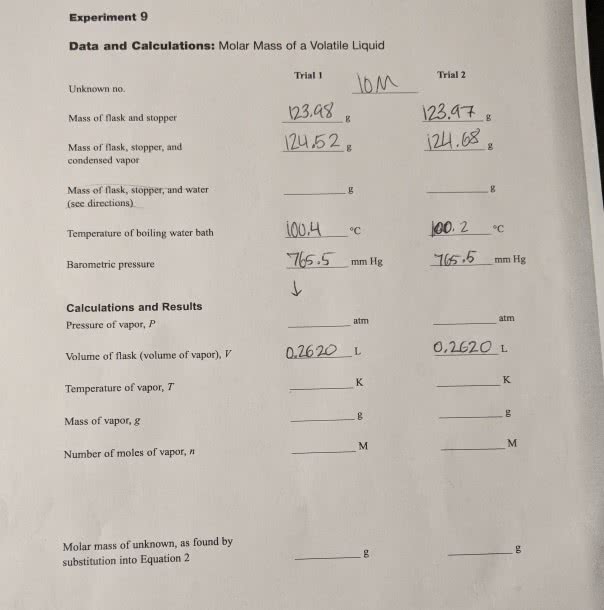Please give me Post lab questions 2 and 3 at the bottom.
Experiment 7 - Molar Mass of a Volatile Liquid
Introduction. Given the mass of vapor at conditions of known pressure, volume, and temperature, one can determine the molar mass of the vapor. The Ideal Gas Law mathematically relates the quantities of pressure (P in atm), volume (V in liters), and temperature (T in Kelvin) and the quantity of gas (n in moles). Using the expression PV=nRT where R equals the Ideal Gas Constant 0.0821 L*atm/K*mol, one can determine the quantity of gas under given conditions of pressure, volume and temperature. The number of moles of gas is found by
PV
RT
n =
Because the molar mass (MM) is defined as the mass of one mole of substance in units of g/mol, the molar mass of the vapor can be determined by
MM= mass of vapor in grams/moles of vapor
In this experiment, an unknown volatile liquid is heated in a boiling water bath and is vaporized. The vapor forces air from the flask until the pressure within the flask equals the barometric pressure of the lab. As with all gases, the vapor occupies the entire volume of its container. The temperature of the vapor equals the temperature of the boiling water bath. After 8-10 minutes, the vapor is cooled. The mass of the condensed liquid is determined and the molar mass is calculated as described above.
Notes:
Check out unknown from stockroom
Record unknown number
Before weighing your condensed vapor, thoroughly dry the outside of the flask and make sure that no water is trapped under the foil cover
Do not rinse your flask with water between trials
Dispose of waste in appropriate container
Procedure. You will record your data and calculations in your lab notebook.
Obtain an unknown liquid and a 3 inch aluminum foil square. You will need two 600 or 800 mL beakers, and 3 or 4 boiling chips.
Add 3 or 4 boiling chips to the water in an 800 mL beaker and heat the water to the boiling point. Continue heating for 8 to 10 minutes after the water comes to a rolling boil. The temperature of the boiling water is 100.0oC. This will be the temperature of the vapor. Convert the temperature to Kelvin and record in your lab notebook.
800 mL Beaker
250 mL Flask
11.
Chemical Molar Mass
1-chlorobutane 92.6 g/mol
t-butyl chloride 92.5 g/mol
trichloroethylene 131 g/mol
2-propanol 60.1 g/mol
Ethyl acetate 88.1 g/mol
n-hexane 86.2 g/mol
cyclohexane 84.2 g/mol
2-butanone 72.1 g/mol
Post Lab Questions: Answer the following questions using complete sentences. Include them after your conclusion.
1. If a lab group did not keep the flask submerged in boiling water for a full ten minutes, and some unknown never vaporized, how would that affect the calculated molar mass? In other words, would it make the calculated value too high or too low? Explain why.
2. While performing this experiment, ten lab groups have ten different unknown volatile liquids with a range of molar masses. If all lab groups have exactly the same size of flask (255 mL), and all groups took their unknown vapor to the same temperature (100.0oC) and pressure (760.0 mmHg), how would the number of molecules within the different flasks compare? Would it vary with molar mass? How? Explain.
3. A student has determined that an unknown liquid is either 1-chlorobutane or t-butyl chloride. What other physical property(s) could be used to determine the identity of the unknown?
Please give me Post lab questions 2 and 3 at the bottom.
Experiment 7 - Molar Mass of a Volatile Liquid
Introduction. Given the mass of vapor at conditions of known pressure, volume, and temperature, one can determine the molar mass of the vapor. The Ideal Gas Law mathematically relates the quantities of pressure (P in atm), volume (V in liters), and temperature (T in Kelvin) and the quantity of gas (n in moles). Using the expression PV=nRT where R equals the Ideal Gas Constant 0.0821 L*atm/K*mol, one can determine the quantity of gas under given conditions of pressure, volume and temperature. The number of moles of gas is found by
|
|
n =
Because the molar mass (MM) is defined as the mass of one mole of substance in units of g/mol, the molar mass of the vapor can be determined by
MM= mass of vapor in grams/moles of vapor
In this experiment, an unknown volatile liquid is heated in a boiling water bath and is vaporized. The vapor forces air from the flask until the pressure within the flask equals the barometric pressure of the lab. As with all gases, the vapor occupies the entire volume of its container. The temperature of the vapor equals the temperature of the boiling water bath. After 8-10 minutes, the vapor is cooled. The mass of the condensed liquid is determined and the molar mass is calculated as described above.
Notes:
Check out unknown from stockroom
Record unknown number
Before weighing your condensed vapor, thoroughly dry the outside of the flask and make sure that no water is trapped under the foil cover
Do not rinse your flask with water between trials
Dispose of waste in appropriate container
Procedure. You will record your data and calculations in your lab notebook.
Obtain an unknown liquid and a 3 inch aluminum foil square. You will need two 600 or 800 mL beakers, and 3 or 4 boiling chips.
Add 3 or 4 boiling chips to the water in an 800 mL beaker and heat the water to the boiling point. Continue heating for 8 to 10 minutes after the water comes to a rolling boil. The temperature of the boiling water is 100.0oC. This will be the temperature of the vapor. Convert the temperature to Kelvin and record in your lab notebook.
| |||||
| | |||||
11.
Chemical Molar Mass
1-chlorobutane 92.6 g/mol
t-butyl chloride 92.5 g/mol
trichloroethylene 131 g/mol
2-propanol 60.1 g/mol
Ethyl acetate 88.1 g/mol
n-hexane 86.2 g/mol
cyclohexane 84.2 g/mol
2-butanone 72.1 g/mol
Post Lab Questions: Answer the following questions using complete sentences. Include them after your conclusion.
1. If a lab group did not keep the flask submerged in boiling water for a full ten minutes, and some unknown never vaporized, how would that affect the calculated molar mass? In other words, would it make the calculated value too high or too low? Explain why.
2. While performing this experiment, ten lab groups have ten different unknown volatile liquids with a range of molar masses. If all lab groups have exactly the same size of flask (255 mL), and all groups took their unknown vapor to the same temperature (100.0oC) and pressure (760.0 mmHg), how would the number of molecules within the different flasks compare? Would it vary with molar mass? How? Explain.
3. A student has determined that an unknown liquid is either 1-chlorobutane or t-butyl chloride. What other physical property(s) could be used to determine the identity of the unknown?



